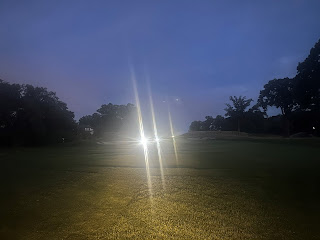Aeration is the most vital thing we do to our turf each year as it has multiple benefits, most of which allow us to provide tournament conditions on a daily basis. However, the question that is baffling is how long does aeration recovery really take?
Do we base it on not seeing holes on the greens anymore? In that case, it would probably take up to 6 weeks for full recovery without seeing a single hole.
Firmness is out the window for a few weeks as we have pulled a lot of cores out of the greens and they are quite unstable until they fully knit in.
Do we base it on green speeds? A big part of it is based on speed and actually not seeing the ball hop on putts, meaning how true and smooth are the greens.
Here is the dilemma when we aerate greens. From the second we finish cleaning plugs off greens, the focus is to get the holes to fill in as soon as possible. That means topdressing greens to ensure holes are filled, fertilizing and also watering more frequently. Weather plays a huge part of recovery, but we can artificially create growth if need be. The most painful part is the first mowings after aeration. The sand ruins mowers for a good 7-10 days after we start mowing as we are only picking up sand and not mowing grass due to dull blades.
Once we start seeing grass in the mower baskets and holes filling in, we start to apply growth regulators since the greens are pretty juiced up with fertilizer. The growth regulators to some regard will slow the recovery down and sometimes we have to get aggressive with growth regulators due to the amount of water and fertilizers we apply. Now that recovery is slowing, we apply more nutrients to help speed it up, all the while trying to produce good playing conditions. It is like running into a wall over and over again.
The smaller the hole we make on the green, the faster it will heal, but the less we are improving the green. The idea is once we are given the ok to aerate, lets get the most out of it and punch as many holes and get as much sand into the green profile as possible. So this year we verticut, aerated and dryjected. A lot of sand went in the green and a lot of surface disruption.

Here is a picture of 15 green today, 22 days after Dryject was completed. I would say this green is almost healed but lets look closely. The green lines you see are tire marks that are fractionally lower than the rest of the green. Once we pull cores the greens are really soft and once we drive equipment over it after (sprayers, topdressers or dryject machines), the tires leave subtle indentations that effect ball roll to some degree. Not noticeable to the eye but on the stimpmeter it matters. Regardless of how much we roll, they are still slightly depressed. The solution; topdress and brush it in so it levels them out. That brings us back to square one where the mowers will be affected, the speeds will then be affected and it adds another few days to recovery. So really, how long does aeration recovery really take?






